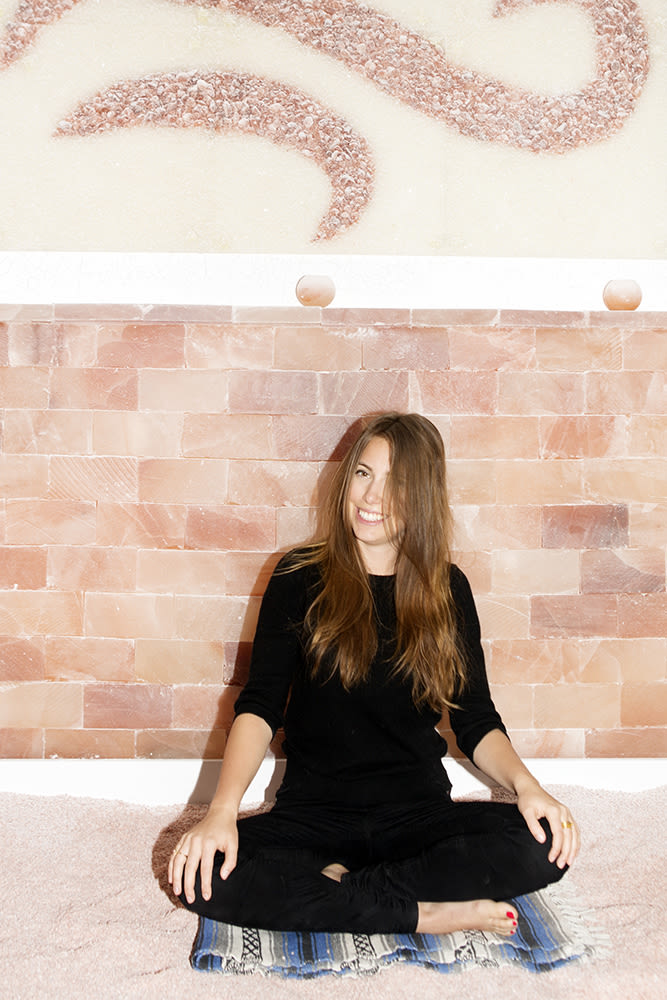Sometimes when I’m sick, congested, and lying in bed surrounded by a sea of tissues, I wonder why I wasn't more grateful for my time breathing normally. It's easy to ignore (which, I guess, is the point of an autonomic nervous system) when it's working, but if you’ve ever had allergies, asthma, or just a really bad cold, you know the painful and miserable feeling of struggling to breathe. It makes you a total social outcast too. I mean, who wants to be friends with the mouth breather? So dear congested ones, if you’ve tried Claritin, Sudafed, NyQuil, DayQuil, and every inhaler in the book to no avail, here’s a new suggestion: Try halotherapy.
Halotherapy (aka salt therapy) is a treatment that involves inhaling salt particles. It's said to be extremely beneficial for a number of respiratory conditions. The process dates way back to the 11th or 12th centuries, when people would visit Eastern Europe’s natural salt caves to heal their ailments. In the 1840s, Dr. Feliks Boczkowski, a Polish doctor who was treating miners, started to study salt’s medicinal properties. He had noticed that while coal miners were plagued with all kinds of respiratory problems, salt miners were emerging with pristine lungs and no health complaints. He published a book on his findings and a few years later, one of his pupils founded the first salt clinic near Kraków, Poland.
Today, you don’t have to trek all the way to Eastern Europe to inhale healing salt. Rooms have been opening all over the US and one of New York's most popular ones, Breathe Easy, has four locations and plans to grow. Founders Gary and Ellen Patrick (he’s the global advertising director at Skechers; she’s a yoga therapist) first learned about the practice when Gary was stuck in London on a business trip and came down with a bad sinus infection. Nothing was helping, so a colleague suggested a salt room. After just a few visits, his symptoms were gone. Now, Gary no longer suffers from any sinus problems. Meanwhile his wife Ellen, a breathing specialist, said she too has noticed a major difference from the treatments including increasing her lung capacity and putting an end to her environmental allergies. Their dog now does salt treatments to relieve his wheezing too!
I personally suffer from all kinds of allergies and have been reading about salt therapy for a while. When I finally got around to stopping by Breathe Easy on a cold afternoon, I wasn’t particularly congested per se, but I had the usual winter runny nose and had felt like a flu was coming on for a few days. In other words, it couldn’t hurt. Walking into the actual salt room felt like something straight out of a sci-fi movie. You remove your shoes and walk across a salt-covered floor to get to your chair. The walls are made of salt blocks, the lamps are made of salt crystals, and everything is coated in a fine, salty dust (including your clothes after a minute or two in the room—don’t wear black). Once you find your way to a chair, all you have to do is sit down, relax, and breathe for about 45 minutes.
In addition to the salt items in the room, there is a “halogenerator' machine pumping atomized salt particles into the air, which you breathe in. But what does that actually do? I checked in with Dr. Alex Eingorn, a New York-based chiropractor and 9/11 first responder, who has used halotherapy himself. According to Eingorn, halotherapy works in two parts. First, the Himalayan salt rocks emit negative ions. As he explains it, injured and diseased cells are electron-deficient, so submitting the body to an electron-rich environment benefits and heals cells by absorption. Second, salt in its microcrystalline form has antiseptic, antibacterial, antifungal, and antiviral effects on the epithelial cells (one of the body’s most important for protection and secretion). The salt helps your cells consolidate inflammation and mucus, so your body can get rid of it. Eingorn said he has seen people with asthma, bronchitis, allergies, cystic fibrosis, psoriasis, and general skin inflammation show major improvement after treatments. There is even some evidence that suggests halotherapy can improve the immune, cardiovascular, and endocrine systems. “After the 9/11 attacks, I sustained serious lung damage,” Eingorn said. “Now, after doing halotherapy regularly for a few months, I am breathing freely. Plus, my wife hasn’t complained about me snoring, which is the greatest benefit!”
To be clear, this is pure Himalayan rock salt. You couldn’t just sniff the stuff from Whole Foods and hope to reap any benefits. As for salt’s reputation as a diet evil? “Ingested salt and inhaled salt are processed very differently by the body,” Eingorn said. So no need to preemptively remove all your tight-fitting rings or anything.
After I finished my treatment, I walked out feeling pretty great. Nothing particular had changed, but my stuffy nose was relieved, and I felt very relaxed. Of course, I rarely sit still for 45 minutes without staring at my phone or computer, so that could definitely have contributed to the effect. I slept like a baby, had a great workout the next day, and never ended up getting that flu I'd been waiting for. Perhaps this is why halotherapy is particularly popular with marathon runners and other athletes who use it to naturally enhance their lung capacity. Co-founder of Breathe Easy Ellen Patrick plans to start hosting yoga and breathing workshops in the rooms this spring. “I want to teach people to focus on breathing better and relieving tension in the muscles associated with the breath,” she said.
At the end of the day, none of this is to say that you should abandon traditional medicine altogether. But if you have a cold or chronic respiratory issues, it’s worth a try. At $40 per session, it won’t break the bank. And if the worst case scenario is that you spend a few minutes unplugged and emerge with some salt on your jeans, things could be worse. Plus, there are all kinds of opportunities for a crazy Instagram moment.
—Victoria Lewis
Photographed by Tom Newton.




